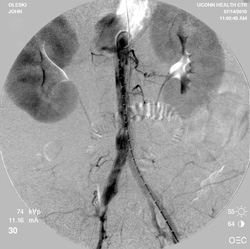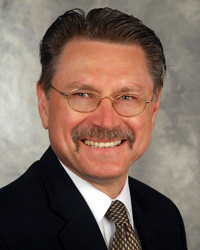Feature Story
Health Center Today, August 4, 2010
First Abdominal Aneurysm Repair Without Surgery in the Hartford Area
By Carolyn Pennington
The first procedure in the Hartford area to repair an abdominal aneurysm using no surgical incision was recently performed at the University of Connecticut Health Center. The procedure was conducted by a team led by Dr. Michael Dahn, vascular surgeon and director of UConn’s Endovascular Program and Services.
The stent used to repair the aneurysm was implanted through small tubes placed through the groin thereby avoiding open surgery. The procedure is done entirely under X-ray guidance. "Since there is no incision, recovery time is very short," says Dahn. "A patient could go back to work the day after surgery. The infection rate is also lower since there is essentially no tissue injury to foster infection."
The new approach called PEVAR (percutaneous endovascular aneurysm reconstruction) has been performed at very few centers throughout the United States and never before in the Hartford region. It is expected that this minimally invasive approach will further reduce the risk of aortic aneurysm repair.
"I was having discomfort in my side and my blood pressure was through the roof," says 54-year-old John Oleski of Newington. "I thought it was appendicitis but when I got to the UConn Health Center, they told me I had an aortic aneurysm. I was shocked – I had never been sick a day in my life."

Angiogram taken at time of procedure.
Abdominal aortic aneurysms result from a lethal weakening in the wall of the abdominal aorta which can rupture resulting in sudden death. Approximately 4 to 5 percent of men over 60 years old are affected by this disease. It is a silent disorder which becomes symptomatic only when an aortic leak or rupture occurs and by then, the risk of death remains high.
Treatment has traditionally involved replacing the aorta with a plastic artery via major vascular surgery. The traditional operation has gradually been replaced by a minimally invasive smaller operation which uses a stent to bypass the aneurysm from the circulation. The risk of this smaller procedure is much lower than the traditional approach and it is much better tolerated by older individuals.
"I was moving around a day after the procedure," explains Oleski. "And I was able to return to work in a little over a week whereas if I had the open surgery I probably would have been out of work for a couple of months."



